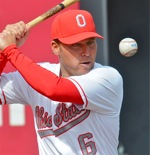It’s something you no longer see in the big leagues, but true baseball men, like Ohio State’s Chris Holick, still believe that pre-game infield drills are essential, and a lost art of the game.
(Ed. Note: As the Buckeyes work out in Florida for the NCAA opening weekend in Port Charlotte next week, we’ll share a profile published three years ago on one of the unique practitioners in all of college baseball. First base coach, and recruiting coordinator, Chris Holick is a specialist in one of the game’s fading arts. He’s one of the best in contemporary baseball in the “art” or hitting pre-game infield. And he tells you why in today’s Press Pros encore presentation of his story. Enjoy!)
Understand, please, that I have a certain affinity for Ohio State assistant coach Chris Holick…and for one important, personal, reason. Holick wears uniform #6.
Forty five years ago I, too, wore number #6 for the Buckeyes, a fact that I shared with him recently when we sat down to talk after a Sunday afternoon game at Bill Davis Stadium.
“You probably did more with the number than I have,” he laughed. “I’m surprised they haven’t retired it.”
No way. From 1971 to 1975 I won a handful of games as a starting pitcher, and led the team one year in wins…with 4. That’s not exactly burning things up.
Holick, for his part, in this day is the first base coach for the Buckeyes, serves as the program’s recruiting coordinator, and before each game engages in one of the lost arts in baseball. Chris Holick hits pre-game “infield” to the nine defensive positions on the field as the last measure of warmup preparation before the game’s first pitch.

We make bats for every level of baseball, and every use…including “fungos”. Phoenix is proud to sponsor the 2018 Buckeyes.
In my 50 years of being around baseball as a player, as a minor league umpire, and as an observer of the college game since 1982, I can rank for you the top practitioners with a “fungo” bat that I’ve seen. A fungo bat, by the way, is a narrowed-down version of a regular ball bat, made specifically to be lighter, and is used to hit ground and fly balls for fielding practice. Chris Holick, for the sake of topical interest in this article, is a specialist practitioner.
The best I’ve ever seen was former Reds coach and minor league manager, Russ Nixon. When Nixon managed in the Florida State League and Southern League he always hit “infield” himself. And his one particular fungo skill was the ability to hit one towering popup after another above home plate, simulating a foul ball that a catcher would catch between the plate and the backstop. He could hit fifty in succession, he once told me, and never miss. Every one of them was a dizzying challenge that turned more than one major league prospect inside-out trying to catch it.
Probably the next best was the late Eddie Brinkman, who for the two years I worked in the Double A Southern League managed the Detroit Tigers entry at Montgomery, Alabama. “Brink” was good…damned good. I never saw him hit fifty popups in a row, but he would flip the bat around while he hit infield. He could hit ground balls with either end, the barrel, or the handle.
Chris Holick belongs in the discussion, as well, although he laughs and admits he might not be able to hit even one popup above home plate, let alone fifty.
 But what makes him unique is the speed with which he pounds one ground ball after another to the Buckeye infielders. He hits “infield” like his hair is on fire.
But what makes him unique is the speed with which he pounds one ground ball after another to the Buckeye infielders. He hits “infield” like his hair is on fire.
“I’m not Russ Nixon good,” he admits. “But I like to do it. I do it with a lot of love and passion because I grew up watching it at old Municipal Stadium in Cleveland. The Indians gave away free tickets to high school varsity letter winners and I was fortunate enough to letter all four years at Westlake High School. My dad was a stickler about going down early to watch batting practice and infield. I thought ‘infield’ was the most amazing thing because it was so crisp, it was so clean, and it was so neatly done. It set the tempo for the game.
“As a player I loved taking infield because it got me ready to go. It got me into the rhythm and speed of the game, and I’ve been lucky because Coach Beals lets me do it here. It’s something I try to do with high tempo and energy because I want the guys to get going at that point. It’s like the first pitch is coming in ten minutes and this is what we’re doing to get ready to play. It’s a routine, and if I’m high energy and high tempo, well, then they’ll feed off it and be ready for the first pitch. I try to hit good hops to the guys so they feel positive about themselves when they take the field.”

‘6’ Now, ‘6’ Then…Chris Holick (left) talks current Buckeye baseball with me. Forty five years ago I wore #6 for the Buckeyes. He wears it now.
His background in baseball is solid, and Holick credits his high school coach at Westlake, Jeff Short, for being a positive early influence that prepared him for stops later as a player at Indiana and Kent State University. His eleven seasons of college coaching experience include positions at Kent, Arizona State, Florida International and Ohio State. At each stop along the way he credits at least one coaching colleague that’s helped prepare him for his current duties as the Buckeyes’ first base coach.
“I try to give our base runners any little tip that I notice about the opposing pitcher, little things that help them get a better jump if they’re stealing a base. I watch the infielders’ positioning if they know a breaking pitch is coming. I pay attention to the outfielders’ arm strength and accuracy. I talk to the guys and try to calm and relax them. Some of them get pretty intense out there.”
In addition, he coordinates the Buckeyes’ recruiting efforts, always looking for the talent necessary to compete for a Big Ten title and beyond. Holick and fellow assistants Mike Stafford, Dan Delucia, and head coach Greg Beals, would like to be recognized along with Ohio State football as a player on the national stage.
“Recruiting is never-ending, and ever-changing,” he shares. “Right now we’re looking at sophomores in high school and those are 2020 grads. And this summer I’ll be looking at 2021 grads, so we’re recruiting far out in the future.”
Like football.
“My role is recruiting coordinator, which means I put together when the better players are playing, where they’re playing, and I go out with Coach Stafford and Coach Beals to see them. We go all over to look at talent. But the big thing that I do is I call all the high school and summer league coaches.
“I want to know from them first about the kids we’re recruiting, especially the high school coaches because they see them in the classroom. Is their attendance good? How do they perform academically, because that’s such an important correlation with baseball. Baseball is such a time-consuming game. And academically if you’re not doing that good that might be a problem. Also, if we get your transcript and find that you missed 17 days of school in a year…that’s not good for us. We’re looking for guys who are tough. Guys who’ll run through a wall. Guys who sprint on and off the field. Obviously, we’re looking for the most talented players, but we’re looking for the intangibles, too.
“I coached Dustin Pedroia and Andre Ethier at Arizona State and you look for guys like that; guys who are good, but also have the little things that someday might get them to the big leagues.”
Those things count in baseball, the little things. And while Chris Holick laughs at the notion of hitting ground balls with either end of the fungo bat, like Eddie Brinkman, he also says he’s willing to try.
Hey, it’s easier than running through a wall…or hitting “infield” with your hair on fire!

“As a player I loved taking infield because it got me ready to go. It got me into the rhythm and speed of the game, and I’ve been lucky because Coach Beals lets me do it here. I take a lot of pride in it (hitting infield).”


"It's a routine, and if I'm high energy and high tempo, well, then they'll feed off it and be ready for the first pitch. I try to hit good hops to the guys so they feel positive about themselves when they take the field." - OSU Assistant Coach, Chris Holick (Press Pros Photos by Sonny Fulks)


